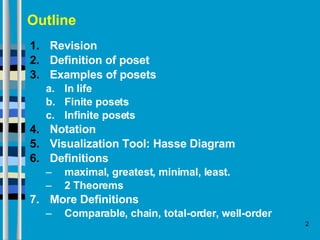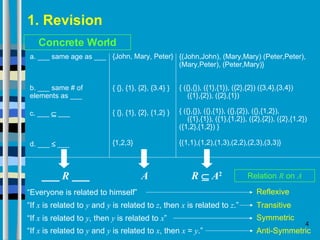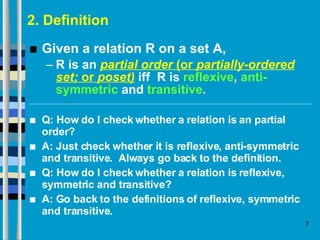L08a
- 1. Lecture 2 (part 1) Partial Orders Reading: Epp Chp 10.5
- 2. Outline Revision Definition of poset Examples of posets In life Finite posets Infinite posets Notation Visualization Tool: Hasse Diagram Definitions maximal, greatest, minimal, least. 2 Theorems 7. More Definitions Comparable, chain, total-order, well-order
- 3. 1. Revision Concrete World Abstract World Relation R from A to B a. ___ has been to ___ {John, Mary, Peter} {Tokyo, NY, HK} {(John,Tokyo), (John,NY), (Peter, NY)} b. ___ is in ___ {Tokyo, NY} {Japan, USA} {(Tokyo,Japan), (NY,USA)} c. ___ divides ___ {1,2,3,4} {10,11,12} {(1,10),(1,11),(1,12), (2,10), (2,12),(3,12), (4,12)} d. ___ less than ___ {1,2,3} {1,2,3} {(1,2),(1,3),(2,3)} ___ R ___ A B R A B Q: What can you do with relations? A: (1) Set Operations; (2) Complement; (3) Inverse; (4) Composition Q: What happens if A = B ?
- 4. 1. Revision Concrete World a. ___ same age as ___ {John, Mary, Peter} {(John,John), (Mary,Mary) (Peter,Peter), (Mary,Peter), (Peter,Mary)} b. ___ same # of elements as ___ { {}, {1}, {2}, {3.4} } { ({},{}), ({1},{1}), ({2},{2}) ({3,4},{3,4}) ({1},{2}), ({2},{1}) c. ___ ___ { {}, {1}, {2}, {1,2} } { ({},{}), ({},{1}), ({},{2}), ({},{1,2}), ({1},{1}), ({1},{1,2}), ({2},{2}), ({2},{1,2}) ({1,2},{1,2}) } d. ___ ___ {1,2,3} {(1,1),(1,2),(1,3),(2,2),(2,3),(3,3)} ___ R ___ A R A 2 Relation R on A “ Everyone is related to himself” Reflexive “ If x is related to y and y is related to z , then x is related to z .” Transitive “ If x is related to y , then y is related to x ” Symmetric “ If x is related to y and y is related to x , then x = y .” Anti-Symmetric
- 5. 1. Revision Given a relation R on a set A, R is reflexive iff x A, x R x R is symmetric iff x,y A, x R y y R x R is anti-symmetric iff x,y A, x R y y R x x=y R is transitive iff x,y A, x R y y R z x R z
- 6. 2. Definition Given a relation R on a set A, R is an equivalence relation iff R is reflexive , symmetric and transitive . ( Last Lecture) R is a partial order iff R is reflexive , anti-symmetric and transitive . (This Lecture)
- 7. 2. Definition Given a relation R on a set A, R is an partial order (or partially-ordered set; or poset) iff R is reflexive , anti-symmetric and transitive . Q: How do I check whether a relation is an partial order? A: Just check whether it is reflexive, anti-symmetric and transitive. Always go back to the definition. Q: How do I check whether a relation is reflexive, symmetric and transitive? A: Go back to the definitions of reflexive, symmetric and transitive.
- 8. 3.1 Examples (Partial Orders in life) PERT - Program Evaluation and Review Technique. CPM - Critical Path Method Used to deal with the complexities of scheduling individual activities needed to complete very large projects. Let T be the set of all tasks. We define a relation R on T such that x R y iff x = y or task x must be done before task y .
- 9. 3.1 Examples (Partial Orders in life) Let T be the set of all tasks. We define a relation R on T such that x R y iff x = y or task x must be done before task y . Q: How long does it take to complete the entire project? (7) (14) (16) (19) (21) (20) (26) Task 1 7 hrs Task 2 6 hrs Task 3 3 hrs Task 7 1 hrs Task 5 3 hrs Task 8 2 hrs Task 9 5 hrs Task 6 1 hrs Task 4 6 hrs (13) (10)
- 10. 3.1 Examples (Partial Orders in life) Let T be the set of all tasks. We define a relation R on T such that x R y iff x = y or task x must be done before task y . Q: Critical Path? (7) (14) (16) (19) (21) (20) (26) Task 1 7 hrs Task 2 6 hrs Task 3 3 hrs Task 7 1 hrs Task 5 3 hrs Task 8 2 hrs Task 9 5 hrs Task 6 1 hrs Task 4 6 hrs (13) (10)
- 11. 3.2 Examples (Finite Partial Orders) Let A = {0,1,2,3,4} Let R = {(0,0), (3,1), (1,1), (0,4), (2,2), (3,4), (3,3), (4,4)} Is R a partial order?
- 12. 3.2 Examples (Finite Partial Orders) Let A = {0,1,2,3,4} Let R = {(0,0), (3,1), (1,1), (0,4), (2,2), (3,4), (3,3), (4,4)} Is R a partial order? Q1: Is R reflexive ? Reflexive : x A, x R x (Always go back to the definition) Yes, R is reflexive.
- 13. 3.2 Examples (Finite Partial Orders) Let A = {0,1,2,3,4} Let R = {(0,0), (3,1), (1,1), (0,4), (2,2), (3,4), (3,3), (4,4)} Is R a partial order? Q2: Is R anti-symmetric ? Anti-symmetric : x,y A, x R y y R x x = y (Again, the definition!)
- 14. 3.2 Examples (Finite Partial Orders) Let A = {0,1,2,3,4} Let R = {(0,0), ( 3 , 1 ), ( 1 ,1), (0,4), (2,2), (3,4), (3,3), (4,4)} Is R a partial order? Q2: Is R anti-symmetric ? Anti-symmetric : x,y A, x R y y R x x = y (Again, the definition!) True Always false LHS: False
- 15. 3.2 Examples (Finite Partial Orders) Let A = {0,1,2,3,4} Let R = {(0,0), ( 3 , 1 ), ( 1 ,1), (0,4), (2,2), (3,4), (3,3), (4,4)} Is R a partial order? Q2: Is R anti-symmetric ? Anti-symmetric : x,y A, x R y y R x x = y (Again, the definition!) LHS: False Vacuously/blankly/stupidly True
- 16. 3.2 Examples (Finite Partial Orders) Let A = {0,1,2,3,4} Let R = {(0,0), (3,1), (1,1), (0,4), (2,2), (3,4), (3,3), (4,4)} Is R a partial order? Q2: Is R anti-symmetric ? Anti-symmetric : x,y A, x R y y R x x = y (Again, the definition!) LHS: False Vacuously True
- 17. 3.2 Examples (Finite Partial Orders) Let A = {0,1,2,3,4} Let R = {(0,0), (3,1), (1,1), (0,4), (2,2), (3,4), (3,3), (4,4)} Is R a partial order? Q2: Is R anti-symmetric ? Anti-symmetric : x,y A, x R y y R x x = y (Again, the definition!) LHS: False Vacuously True
- 18. 3.2 Examples (Finite Partial Orders) Let A = {0,1,2,3,4} Let R = {(0,0), (3,1), (1,1), (0,4), (2,2), (3,4), (3,3), (4,4)} Is R a partial order? Q2: Is R anti-symmetric ? Anti-symmetric : x,y A, x R y y R x x = y (Again, the definition!) Carry on checking… Yes, it’s anti-symmetric
- 19. 3.2 Examples (Finite Partial Orders) Let A = {0,1,2,3,4} Let R = {(0,0), (3,1), (1,1), (0,4), (2,2), (3,4), (3,3), (4,4)} Is R a partial order? Q3: Is R transitive ? Transitive : x,y,z A, x R y y R z x R z (DEFINITION!!!)
- 20. 3.2 Examples (Finite Partial Orders) Let A = {0,1,2,3,4} Let R = {( 0 , 0 ), (3,1), (1,1), ( 0 , 4 ), (2,2), (3,4), (3,3), (4,4)} Is R a partial order? Q3: Is R transitive ? Transitive : x,y,z A, x R y y R z x R z (DEFINITION!!!) True True True True
- 21. 3.2 Examples (Finite Partial Orders) Let A = {0,1,2,3,4} Let R = {(0,0), ( 3 , 1 ), ( 1 , 1 ), (0,4), (2,2), (3,4), (3,3), (4,4)} Is R a partial order? Q3: Is R transitive ? Transitive : x,y,z A, x R y y R z x R z (DEFINITION!!!) True True True True
- 22. 3.2 Examples (Finite Partial Orders) Let A = {0,1,2,3,4} Let R = {(0,0), (3,1), (1,1), (0,4), (2,2), (3,4), (3,3), (4,4)} Is R a partial order? Q3: Is R transitive ? Transitive : x,y,z A, x R y y R z x R z (DEFINITION!!!) Carry on checking… Yes, R is transitive.
- 23. 3.3 Examples (Common Infinite Posets) Let R be a relation on Z, such that x R y iff x y R is a partial order Reflexive: x Z, x x Anti-symmetric: x,y Z, x y y x x=y Transitive: x,y,z Z, x y y z x z We will abbreviate the description of this relation to R = (Z, )
- 24. 3.4 Examples (Common Infinite Posets) Let R be a relation on Z + , such that x R y iff x | y R is a partial order Reflexive: x Z + , x | x Anti-symmetric: x,y Z + , x|y y|x x=y Transitive: x,y,z Z + , x|y y|z x|z We will abbreviate the description of this relation to R = (Z + , | )
- 25. 3.5 Examples (Common Infinite Posets) Let R be a relation on P(A), such that X R Y iff X Y R is a partial order Reflexive : X P(A), X X Anti-symmetric : X,Y P(A), X Y Y X X=Y Transitive : X,Y,Z P(A), X Y Y Z X Z We will abbreviate the description of this relation to R = (P(A), )
- 26. 4. Notation In general, if we describe a partial order relation as: Let R be a relation on A, such that x R y iff x op y … we will shorten the description to R = (A, op ) Of course, this can be done only when the relation can be described in terms of a simple operator . We will not be able to this if the relation is described by a complicated logical expression
- 27. 4. Notation In general, if we describe a partial order relation as: Let R be a relation on A, such that x R y iff x op y … we will shorten the description to R = (A, op ) Hence we have : 1. R = (Z, ) 2. R = (Z + , | ) 3. R = (P(A), )
- 28. 4. Notation There are times when we discuss partial orders in general . In such cases we may write: R = (A, ) as a general partial order. We choose the ‘ ’ symbol to represent a general ordering operator because it looks like ‘ ’. This is done due to the fact that the ordering of the elements in the set convey the idea of one below the other (something like on Z).
- 29. 5. Visualisation Tool: Hasse Diagram Let A = {0,1,2,3,4} Let R = {(0,0), (3,1), (1,1), (0,4), (2,2), (3,4), (3,3), (4,4), (1,4)} 0 3 1 4 2 Let’s simplify the diagram 1. Eliminate all reflexive loops. 0 3 1 4 2
- 30. 5. Visualisation Tool: Hasse Diagram Let A = {0,1,2,3,4} Let R = {(0,0), (3,1), (1,1), (0,4), (2,2), (3,4), (3,3), (4,4), (1,4)} 0 3 1 4 2 Let’s simplify the diagram 2. Eliminate all transitive arrows. 0 3 1 4 2 0 3 1 4 2
- 31. 5. Visualisation Tool: Hasse Diagram Let A = {0,1,2,3,4} Let R = {(0,0), (3,1), (1,1), (0,4), (2,2), (3,4), (3,3), (4,4), (1,4)} 0 3 1 4 2 Let’s simplify the diagram 3. (a) Draw all arrow heads pointing upwards, and (b) eliminate arrow heads. 0 3 1 4 2 0 3 1 4 2 0 3 1 4 2
- 32. 5. Visualisation Tool: Hasse Diagram Let A = {0,1,2,3,4} Let R = {(0,0), (3,1), (1,1), (0,4), (2,2), (3,4), (3,3), (4,4), (1,4)} 0 3 1 4 2 The result is a Hasse Diagram . 0 3 1 4 2 0 3 1 4 2 0 3 1 4 2
- 33. 5. Visualisation Tool: Hasse Diagram Let A = {0,1,2,3,4}. Let R = (A, Draw the Hasse Diagram. 1. Eliminate all reflexive loops. 0 4 2 1 3
- 34. 5. Visualisation Tool: Hasse Diagram Let A = {0,1,2,3,4}. Let R = (A, Draw the Hasse Diagram. 0 4 2 1 3 1. Eliminate all reflexive loops. 2. Eliminate all transitive arrows.
- 35. 5. Visualisation Tool: Hasse Diagram Let A = {0,1,2,3,4}. Let R = (A, Draw the Hasse Diagram. 0 4 2 1 3 1. Eliminate all reflexive loops. 2. Eliminate all transitive arrows.
- 36. 5. Visualisation Tool: Hasse Diagram Let A = {0,1,2,3,4}. Let R = (A, Draw the Hasse Diagram. 0 4 2 1 3 1. Eliminate all reflexive loops. 2. Eliminate all transitive arrows. 3. (a) Draw all arrow heads pointing upwards, and (b) eliminate arrow heads.
- 37. 5. Visualisation Tool: Hasse Diagram Let A = {0,1,2,3,4}. Let R = (A, Draw the Hasse Diagram. 0 4 2 1 3 1. Eliminate all reflexive loops. 2. Eliminate all transitive arrows. 3. (a) Draw all arrow heads pointing upwards, and (b) eliminate arrow heads.
- 38. 5. Visualisation Tool: Hasse Diagram Let A = {1,2,3,…,10}. Let R = (A, | Draw the Hasse Diagram. You may draw the Hasse Diagram immediately if you are able to. 1 2 3 5 7 10 4 8 9 6
- 39. 5. Visualisation Tool: Hasse Diagram Let A = {1,2,3}. Let R = (P(A), Draw the Hasse Diagram. R = ( { {} , {1} , {2} , {3} , {1,2} , {1,3} , {2,3} , {1,2,3} } , ) {} {1} {3} {2} {1,2} {1,3} {1,2,3} {2,3}
- 40. To be continued








































